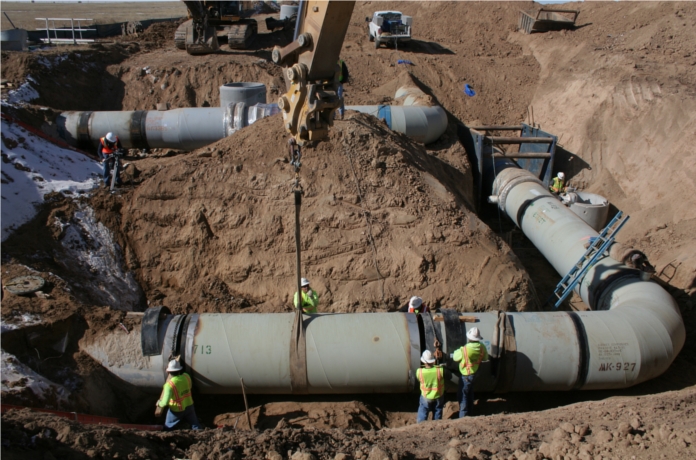May 2010 Vol. 65 No. 5
Features
Aurora Prairie Waters Project Nears Completion

Workers placed the last piece of the Aurora Prairie Waters Project supply pipe on Thursday, February 11, 2010, nearly two years after pipeline construction began. The Prairie Waters Project will help drought-harden the city of Aurora, CO, beginning in 2011.
Workers lowered the final piece of 60-inch mortar-lined, urethane-coated steel pipe with a crane into a 10-foot deep trench near the Aurora Reservoir and welded it into place. In total, workers installed 34 miles of 60-inch pipe from Weld County to the Aurora Reservoir.
“This moment is more than the end of major activities for the conveyance pipeline,” said Darrell Hogan, Prairie Waters Project program director. “This marks a beginning for our final push to conclude construction activities by the end of the year. The project is on schedule and projected to be under budget.”
The project broke ground in July of 2007 as work began on the Peter D. Binney Water Purification Facility, located north of the Aurora Reservoir. Pipeline activities began in March of 2008 to connect the North Campus, a natural purification area located along the South Platte River north of Brighton, to the new water purification facility. The completed pipeline will initially allow for 10,000 acre-feet of water to be delivered to Aurora.
Segments
The pipeline was installed in three segments, with more than half of the pipeline following E-470 into Aurora. The first segment, constructed by Reynolds Tierdael, meandered from the South Platte River near Brighton, through areas of unincorporated Adams County and ended in Commerce City. A second segment, constructed by S.J. Louis Construction of Texas Ltd., was installed along E-470 past the Denver International Airport and into Aurora. The third pipeline segment, constructed by Garney Construction, meandered through Aurora, ending at the new
purification facility site where the final piece of pipe was installed.
In total, 22 tunnels were constructed under roadways, waterways and railroad crossings to mitigate impacts to the surrounding community and protect sensitive environmental areas. Through February, the overall project was 90 percent complete. Work is scheduled to conclude on the projects’ three pumping stations in May. Workers will then begin testing the conveyance system and delivering water to the new treatment facility.
The Prairie Waters Project is the fastest, cost-effective and environmentally sustainable way to enhance Aurora’s water supply. During 2003, the city had less than a nine-month supply of water due to a prolonged drought. To protect Aurora from future drought impacts, the Prairie Waters Project was developed to utilize existing return flows from its transbasin diversions and transferred agriculture rights.
The $754 million project should complete all construction phases on schedule in late 2010. It will deliver up to 3.3 billion gallons of water to Aurora residents and businesses.
North Campus
Multiple tunnel crossings under jurisdictional waterways were needed during construction. Construction activities were closely coordinated with environmental monitors as well as state and federal regulators to help protect sensitive wetland areas during these activities. All 17 riverbank wells are installed and undergoing performance testing. The 36-inch pipeline leading from the natural purification area to pump station one is complete.
Once operational, the North Campus will use natural purification for initial water treatment to naturally cleanse the city’s existing South Platte River resources.
All pumps have been delivered to each site. Each pump station holds one 600 and one 1,250 horse power pump. Crews continue electrical and mechanical installation, as well as work on architectural elements for each facility.
Advanced electronics and communication systems allow the facilities to operate from a central control facility miles away, thus requiring minimal staff at each pump station site.
Water purification
This facility is located just north of the Aurora Reservoir. The complex consists of 13 buildings. In January, crews installed bulbs and electrical components to the massive ultraviolet generators that makeup the advanced ultraviolet oxidation system. Workers continue installing electrical components throughout the facility, as well as preparing system startup checks.
More than 2.2 million cubic yards of dirt have been excavated for the facility. This is enough dirt to fill about eight oil barrels for every household in the Denver/Aurora metro area.
FOR MORE INFO:
Prairie Waters Project, 303-739-7477 www.prairiewaters.org.




Comments